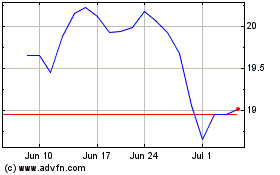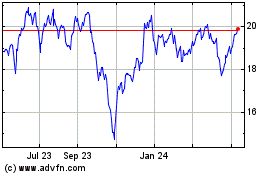Housing Regulator Closes Loan Loophole Used by REITs
January 12 2016 - 4:47PM
Dow Jones News
By Joe Light
A top federal housing regulator on Tuesday shut the door on
mortgage investors who had been using a loophole to access
low-cost, government-backed financing.
The Federal Housing Finance Agency said so-called captive
insurance companies, which insure the risks of the companies that
own them, no longer will be eligible for membership in
government-backed federal home loan banks.
Real-estate investment trusts that invest in mortgages are
normally ineligible for home-loan-bank membership, but over the
past few years have created captive insurers to gain indirect
access to cheap federal funding.
After the announcement on Tuesday, shares of some mortgage REITs
with captive insurers, such as Annaly Capital Management Inc., Two
Harbors Investment Corp. and Redwood Trust Inc., fell between 0.9%
and 5%.
Mortgage experts said the move is likely to make it even more
difficult for some riskier borrowers who don't fit the parameters
of government-backed agencies to get loans.
"It will make some loans to lower-quality borrowers even slower
to come back," said Laurie Goodman, director of the Housing Finance
Policy Center at the Urban Institute, a think tank.
Mortgage rates also could tick up, since the rules would
effectively cut off some investment in mortgage bonds.
On the other hand, some had feared that allowing captive
insurers to get access could put the FHLB system at risk, as other
types of firms like hedge funds and investment banks considered
using the workaround.
"Congress has had plenty of opportunities to give [mortgage
REITs] access to the system, and they haven't done so," said Joseph
Pigg, senior vice president for mortgage finance for the American
Bankers Association, a banking industry trade group.
The 11 regional federal home loan banks advance low-cost loans
to financial institutions such as credit unions and commercial
banks to promote lower mortgage rates.
In shutting captive insurers out, FHFA Director Melvin Watt said
the agency sought to abide by Congress's intent when it passed the
law governing the home loan bank system.
As of the end of September, 40 captive insurers had become
home-loan bank members and as of mid-November, they had outstanding
borrowings of more than $35 billion.
In a statement, John von Seggern, president of the Council of
FHLBanks, said the FHFA's decision "will mean fewer opportunities
for private capital to expand homeownership opportunities for
Americans."
Mortgage Bankers Association President David Stevens said the
rule "removes a vital component of the FHLBank membership which
provides liquidity for the real estate finance market."
On Tuesday, the FHFA did roll back separate provisions that
would have required home-loan bank members to keep a certain
percentage of their assets in mortgages. That move is expected to
help liquidity.
The FHFA first proposed the changes in September 2014. A
bipartisan group of congressmen in October last year introduced a
bill that would require the FHFA to withdraw the proposal, though
that legislation never left committee.
Mortgage REITs that have already used insurers to get home-loan
bank access will get some relief. Those that entered the system
before the September 2014 proposal can stay members for up to five
years, while those that became members after will have one
year.
Michael Widner, an analyst for Keefe, Bruyette & Woods, said
that because of the uncertainty surrounding membership, mortgage
REITs until now have hesitated to rely on the home-loan banks for a
large portion of their funding. In part for that reason, he said he
didn't expect the FHFA's decision to have a near-term impact on
REIT earnings. Mr. Widner said 19 of 24 publicly traded mortgage
REITs had captive insurers that were home-loan bank members.
Annaly CEO Kevin Keyes said mortgage REIT membership in the FHLB
system "enhances both the stability of the residential financing
market and is supportive of the federal government's broader goal
of returning private capital to the U.S. mortgage market."
Write to Joe Light at joe.light@wsj.com
(END) Dow Jones Newswires
January 12, 2016 16:32 ET (21:32 GMT)
Copyright (c) 2016 Dow Jones & Company, Inc.
Annaly Capital Management (NYSE:NLY)
Historical Stock Chart
From Mar 2024 to Apr 2024

Annaly Capital Management (NYSE:NLY)
Historical Stock Chart
From Apr 2023 to Apr 2024
